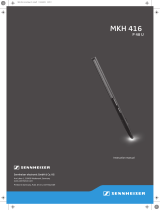
Principleof HighFrequencyCircuit
The capsule 01a RF condenser microphone presents, contrary to
low Irequency circuits, a low impedance output. Instead 01the high
polarization voltage normally required, a high Irequency capsule
needs only a high Irequency voltage 01about 10 volts, wh ich is pro-
duced bya built-in low noise oscillator (8 MHz). The low capsule
impedance leads to a high performance reliability 01the micro-
phones.
microphone is being used for professional studio purposes, this is not
critical, as the large output voltage of the microphone combined with
its low output impedance provides a large signal to noise ratio. Care
should be taken, however, that no multiple ground circuits are
lormed when the microphones are mounted on tripods etc.
Powering and Connection
Sennheiser electronic introduced A-B powering, which was then
standardised in DIN 45595. As with dynamic microphones, only .
two wires are required to connect the microphone when this
powering system is being used. The operating current is led along
the same wires as the audio Irequency signal, so that the circuitry in
the microphone does not have to be connected to earth. Because
01this earth Iree technique the highest possible values 01
immunity Irom noise or disturbance are achieved.
The connection 01 Sennheiser condenser microphones and
dynamic microphones as weil is carried out using the principle 01
voltage matching. The advantages 01this system are that neither
impedance vBriations 01the microphone output nor 01the amplilier
input exercise a noticeable inlluence on the total Irequency
response. The source impedance 01the Sennheiser condenser
microphones with A-B powering is so low (approx. 8 Q at 1000 Hz)
that an amplilier input with an impedance 01at least 400 Q will be
suitable. This is usual in the majority 01cases. However, il the
input impedance is smaller than 400 Q, a resistor 01appropriate
value should be placed in series with the microphone so that it
"sees" at least 400 Q. The voltage division caused by this series
resistor must 01course be considered. The same method can be
used when a highter output impedance 01the microphone is
demanded. In this case again aseries resistor can be used to
provide correct matching.
Sennheiser condenser microphones produce relatively large output
voltages, these can be up to 1 volt with maximu[TI sound pressure
levels. This has the advantage that even with long cables induced
interference signals can be disregarded. Also the internal noise
produced by the microphone does not contribute to the total noise
level. The microphones are litted with high Irequency lilters, which
ensure that no high Irequency signals Irom the microphone can
affect the external circuitry, and also that the microphone itsell is
protected lrom high Irequency disturbance. It is, therelore, not
necessary, even under the most difficult conditions, to take special
precautions such as double screening 01the cables or the
provision 01high Irequency lilters.
Sennheiser condenser microphones are polarised according to DIN'
standard i. e. when pressure signal strikes the capsule Irom the
Iront, pin 1 (pin 2 lor MKH 416 TU-3) goes positive with relerence
to pin 3. This should be considered when the amplilier input plug
is being wired.
Connection to microphone inputs with high sensitivity
If the unit being used has a very high input sensitivity, i.e,
when it is normally intended lor use with dynamic microphones, it
can be necessary to reduce the output voltage Irom the microphone
by means 01a voltage divider, wh ich should be built into the micro-
phone cable at the amplilier input. By this means the large signal on
the microphone cable is maintained up to just belore the amplilier,
which results in a increased signal to noise ratio.
Connection to mixer and sound recording equipment with
powering facilities
II an appropriate voltage source is available the condenser
microphone can be powered directly. The voltage should
be 12 volts :t 2 volt. It should be so stabilised and liltered, that the
unweighted noise voltage is less than 5 flV and that the weighted
noise components are less than 2 flV. The current consumption 01
the microphone is approximately 6 mA. According to the DIN
standard the resistors should be 2 x 180 Q. This means that the
voltage drop across the resistors is approx. 2 V.
,---y
n,
, ,
, ,
, ,
, ,
, ,
, ,
, ,
, ,
i L ,
! ---1
1
'---
====l::==~
180Q , , L_-
12V (j S
Balanced
A-B powering
according to DIN45595
3600 +12V
i ---r :
, ,
, ,
, ,,
, ,
, ,
, ,
, ,
i L n'
NF
+'~
Connection to balanced, floating microphones inputs
In this case the microphone is simply connected to the input 01an
amplilier via a powering adapter MZA 16 T or the power supply unit
MZN 161.
-12V
Connection to unbalanced microphone inputs
In many cases, lor example most tape recorders, the input socket
is unbalanced. In this case one pin 01the balanced microphone
output has to be earthed (prelerably pin 3). When using the power
supply unit MZN 16 T an unbalanced operation only is possible after
a modilication 01the power supply unit. Apart lrom cases where the
7
,---y ,
, ,
, ,
, ,
i ;2'
I
' "
, ,
, ,
i---L i
NF
T'b
f:t
Unbalanced A-B powering
8






